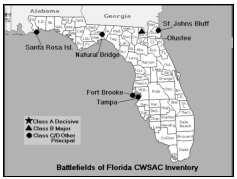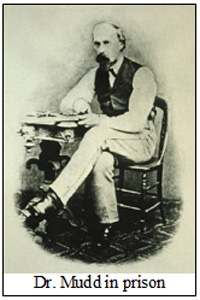
Volume
28, No. 8 – August 2015
Volume 28, No. 8
Editor: Stephen L. Seftenberg
Website:
www.CivilWarRoundTablePalmBeach.org
President’s Message
At the July meeting several people asked me why we were not discussing
current events. The purpose of the Round Table is the study and
discussion of the Civil War, the years prior and immediately thereafter.
It is not appropriate for the Round Table to offer an opinion on any
recent political issues.
Due to space limitations,
the printed version of the newsletter could not contain this paragraph. Two items: one good, one
bad. First the good: Our
favorite holiday speaker, Robert Macomber, will speak to us on
Wednesday, December 9 at 7 PM.
He will also give a talk at the Four Arts on Tuesday, December 8,
2015 (the day before our meeting), beginning at 5:30 PM. At both
meetings, he will assuredly discuss his newest book, “Assassin’s Honor.”
Then the bad news: I got a letter from Mary Barnt, editor of the Peace
River Civil War Roundtable that her roundtable has ceased to exist. We
are fortunate in maintaining interest, with an inviting speakers,
website and newsletter, with over 40 attendees at the July meeting.
But we always need new blood to grow let alone survive. Bring a
friend to the next meeting!
Gerridine LaRovere, President
August 12, 2015
Meeting
Lavinia (“Ellie”) Ream (9/23/1847 -
11/20/1914)
Our President says, “I read a brief article about
Vinnie Ream in a Civil War magazine and found her fascinating. She is
not a well-known name; but the more research I did, the more captivating
she became. Vinnie was petite, astute, well-connected, confident, and
artistically talented. Her friends and acquaintances were a compendium
of many Civil War personalities. Benjamin Butler, “the Beast of New
Orleans,” despised her, but General William Tecumseh Sherman was
enamored of her. While married, Sherman corresponded with her for four
years. Were the letters intimate or just flowery Victorian prose? At the
age of 18 she was the first women to receive a federal commission to
make a life-size statue of the slain President Lincoln. Was Vinnie
responsible for influencing the single vote by which President Andrew
Johnson escaped conviction in the Senate? Was she a talented, dedicated
artist with good political connections or just a wily self-promoter? See
you in August, and you be the judge.
July 8, 2015 Meeting
“The Smallest Tadpole in the Dirty Pool of Secession” – Florida in the
Civil War
 Eliot Kleinberg, born in
South Florida, has spent nearly four decades as a reporter, including
more than a quarter-century at The Palm Beach Post in West Palm Beach.
He has written 10 books, all focusing on Florida, including "Black
Cloud," on the great 1928 Okeechobee Hurricane; two "Weird Florida"
books; and "Palm Beach Past" and "Wicked Palm Beach," both collections
of items from his weekly local history column in the Post. His tenth,
“Peace River,” is a historical novel based at the end of the Civil War.
The son of longtime prominent South Florida journalist Howard Kleinberg,
he is a University of Florida graduate,
a member of the Florida, South Florida and Palm Beach County
Historical Societies. He and his wife are the parents of two adult sons
and live in suburban Boca Raton. Eliot Kleinberg, born in
South Florida, has spent nearly four decades as a reporter, including
more than a quarter-century at The Palm Beach Post in West Palm Beach.
He has written 10 books, all focusing on Florida, including "Black
Cloud," on the great 1928 Okeechobee Hurricane; two "Weird Florida"
books; and "Palm Beach Past" and "Wicked Palm Beach," both collections
of items from his weekly local history column in the Post. His tenth,
“Peace River,” is a historical novel based at the end of the Civil War.
The son of longtime prominent South Florida journalist Howard Kleinberg,
he is a University of Florida graduate,
a member of the Florida, South Florida and Palm Beach County
Historical Societies. He and his wife are the parents of two adult sons
and live in suburban Boca Raton.
Eliot started out by
stating that the “average” resident of Palm Beach County knows nothing
about the history of Florida in the Civil War and that he sees one of
his missions in life being to bring the fascinating story to the public
(currently, with his January 8, 2015 column in the Neighborhood Post
section down to his June 11, 2015 column).
Eliot then debunked the factoid that Florida was so named because
the sailors saw flowers on the beach. In reality, the discovery came
during the Festival of Flowers in Spain.
What were the real
motives for secession? For
the “average” Floridian, it may have been to protect my land from Damn
Yankee invaders, but for the ruling class, it was clearly to protect
slavery. The “Declarations
of Secession” adopted by the various states usually were silent on the
reasons, but the underlying cause was clearly spelled out in the
“Declaration of Immediate Causes Which Induce and Justify the Secession
of South Carolina from the Federal Union,” dated December 24, 1860:
The specific issues stated were the refusal of some states to
enforce the Fugitive Slave Act and clauses in the U.S. Constitution
protecting slavery and the federal government's perceived role in
attempting to abolish slavery. “...while these problems had existed for
twenty-five years, the situation had recently become unacceptable due to
the election of a President who was planning to outlaw slavery... [and
the] ... increasing hostility on the part of the non-slaveholding States
to the Institution of Slavery.”
Not all slave holders
favored secession. On January 7, 1861, the secession convention voted
that Florida should legally resign from the United States. When the
secession ordinance was read on the east portico of the capitol building
before a cheering crowd, former territorial governor Richard Keith Call
(10/24/1792 - 9/14/1862), one of the founding fathers of Florida statehood
and one of the state’s largest slave-holders, angrily cried that the
delegates had “opened the gates of Hell, from which shall flow the
curses of the damned which shall sink you to perdition!”
 The Civil War almost
started at Fort Pickens, on Santa Rosa Island. On January 10, 1861, the
same day Capt. Anderson consolidated his forces in Fort Sumter, South
Carolina, Lt. Adam J. Slemmer consolidated the men in the 5 forts
bordering Pensacola Bay in Fort Pickens and refused to surrender it. The
Confederates, under Braxton Bragg, planned to attack on April 12, 1861,
but balked when they learned that Fort Sumter had been bombarded and
captured, triggering war and allowing Fort Pickens to be resupplied and
reinforced and remain in Union hands. The Civil War almost
started at Fort Pickens, on Santa Rosa Island. On January 10, 1861, the
same day Capt. Anderson consolidated his forces in Fort Sumter, South
Carolina, Lt. Adam J. Slemmer consolidated the men in the 5 forts
bordering Pensacola Bay in Fort Pickens and refused to surrender it. The
Confederates, under Braxton Bragg, planned to attack on April 12, 1861,
but balked when they learned that Fort Sumter had been bombarded and
captured, triggering war and allowing Fort Pickens to be resupplied and
reinforced and remain in Union hands.
Despite secession fever,
there were many pockets of Union loyalists. The sparse population meant
that the biggest battles took place in Virginia and along the
Mississippi River and most of the eligible white men in Florida went
North or West to fight. Of the 70,679 white citizens listed in the 1860
census, Florida sent over 15,000 men and boys to fight for the
Confederacy, of whom over 5,000 died (both statistically the heaviest
contribution by any state). However, there were celebrated battles North
of Palm Beach – Santa Rosa Island (10/9/1861), Tampa (6/30-7/1/1862),
St. John’s Bluff (10/1-10/3/1862, Fort Brooke (10/16-18/1863) and the
two most celebrated battles, Olustee (2/20/1864), and finally Natural
Bridge (03/06/65). More about the last two battles later.
One incident in our area
was the not-so-bloody Battle of the Jupiter Lighthouse. Confederate blockade-runners familiar with the waters didn't need the light
(which used a Fresnel lens) and didn't want it revealing them to
Union patrols. Assistant keeper August Oswald Lang, a German immigrant
and a proud citizen of the Confederate States of America, ordered his
boss to surrender the lighting mechanism. Keeper J. F. Papy, loyal to
his federal paycheck, said no, but was convinced otherwise. The rebels
hid the key components of the beacon, and it was recovered after the war
and is still in place in the lighthouse.
blockade-runners familiar with the waters didn't need the light
(which used a Fresnel lens) and didn't want it revealing them to
Union patrols. Assistant keeper August Oswald Lang, a German immigrant
and a proud citizen of the Confederate States of America, ordered his
boss to surrender the lighting mechanism. Keeper J. F. Papy, loyal to
his federal paycheck, said no, but was convinced otherwise. The rebels
hid the key components of the beacon, and it was recovered after the war
and is still in place in the lighthouse.
Eliot pointed out that
with the capture of Vicksburg, on the Mississippi River, Century Village
would not exist! Why? When
it surrendered, the railroad to Texas, which had been the “Rebel
Warehouse,” the source of beef, pork, salt, turpentine and soldiers, was
cut and the Confederates turned to Florida as a replacement.
President Lincoln, facing
a tough reelection campaign in 1864, saw Florida as the weakest of the
Southern states. He asked
his generals to work up a plan to capture Tallahassee.
The result? The Battle of Olustee (2/20/1864), viewed by the
South as a “rout,” was the second bloodiest battle in the war, measured
by the percentage of killed and wounded to total engaged. (Note:
In the aftermath there is substantial evidence that Confederate militia
men killed Union black soldiers who were wounded or attempting to
surrender.)
It is also the scene of large annual Reenactments (February 13-14,
2016). The last major battle in Florida was the Battle of Natural Bridge
(March 6, 1865). Union
forces, attacking from the West, were met by a hastily-gathered force
consisting of Seminole War veterans (the “Gadsden Grays”) and military
cadets from the Florida Military and Collegiate Institute that would
later become Florida State University, hated rivals of Eliot’s alma
mater, University of Florida. The result was another smashing
Confederate victory that meant that Tallahassee was the only Southern
capital never to fall to a Northern army during the war.
By the end of the
fighting, Florida was flat on its back.
One final casualty was its governor, John Milton, who committed
suicide rather than surrender.
For some time there would be no effective government in the parts
of the state that had been controlled by the Confederacy. The war would
end in ignominy and flight – Some, Judah P. Benjamin (who had been
Confederate Attorney General, Secretary of War and Secretary of State,
and John C. Breckinridge (who had been Vice President of the United
States under Buchanan, a U. S. Senator for 9 months, a Brigadier General in the Confederate Army and finally for one month, Confederate Secretary
of War) both escaped to England. President Jefferson Davis almost made
it to Florida, being captured near Irwinville, Georgia.
Dr. Samuel Mudd 12/20/1833-1/10/1883), who treated John Wilkes
Booth after Booth broke his leg jumping from Lincoln’s box seat, was
sentenced to life imprisonment in Fort Jefferson, in the Dry Tortugas 70
miles West of Key West. When
Mudd tried to escape he was shifted from the hospital to the carpentry
shop, where he wore leg irons while working there.
In 1867, Mudd saved many lives in a Yellow Fever epidemic.
President Andrew Johnson pardoned Mudd on February 18, 1869, but
efforts to expunge his conviction continue to this day.
Two Presidents, Jimmy Carter and Ronald Reagan, have expressed
their belief that Mudd was innocent of any crime. Fort Jefferson is now
a tourist attraction, but has a blank military history. By the time it
was finished, its 420 cannons were obsolete and could not reach enemy
ships whose own cannons had the fort in their range.
in the Confederate Army and finally for one month, Confederate Secretary
of War) both escaped to England. President Jefferson Davis almost made
it to Florida, being captured near Irwinville, Georgia.
Dr. Samuel Mudd 12/20/1833-1/10/1883), who treated John Wilkes
Booth after Booth broke his leg jumping from Lincoln’s box seat, was
sentenced to life imprisonment in Fort Jefferson, in the Dry Tortugas 70
miles West of Key West. When
Mudd tried to escape he was shifted from the hospital to the carpentry
shop, where he wore leg irons while working there.
In 1867, Mudd saved many lives in a Yellow Fever epidemic.
President Andrew Johnson pardoned Mudd on February 18, 1869, but
efforts to expunge his conviction continue to this day.
Two Presidents, Jimmy Carter and Ronald Reagan, have expressed
their belief that Mudd was innocent of any crime. Fort Jefferson is now
a tourist attraction, but has a blank military history. By the time it
was finished, its 420 cannons were obsolete and could not reach enemy
ships whose own cannons had the fort in their range.
The Civil War was a
calamity for Florida, as it was for the Confederate states.
However, a bright spot was that many Northern soldiers posted
there during Reconstruction were attracted to snow-free living.
Florida passed a law encouraging the building of railroads from
the North to foster tourism. Henry Flagler, induced by the grant of
2,000 acres of land, laid 300 miles of track to the “American Riviera,”
leading to the first “Boom.” Eliot sees Florida’s history as a moving
“jump rope” – booms (1880s, 1920, post-World War II) followed by bust.
The population tells the story: 1940 (2 million), 1950 (3
million), 1970 (7 million) and 2015 (20 million).
In conclusion, Eliot
reiterated his conclusion that the Civil War was a catastrophic
disaster. To continue to argue over its “cause” is a useless waste.
We should honor the dead and the maimed on both sides, including
the many wives, widows and children on the home front who also suffered
greatly. The greatest
“thing” to remember about the Civil War is the fact that we fought it.
It should not be romanticized and should not include revisionist history
for political purposes. For whatever reasons it was fought, the South
“lost” the war, and should have “gotten over it” by now.
After his rousing talk,
Eliot Kleinberg answered questions and received equally rousing
applause.
[Editor’s comment: The
day of Eliot’s talk, author Peter Manseau wrote an article in The New
York Times entitled, “The Many Images of Jefferson Davis,” in which he
says, “Among Southerners, the abuse [Davis] endured – at the hands of
both wags like Barnum and his jailers at Virginia’s Fort Monroe – took
on a life of its own. His suffering became the passion play of the Lost
Cause, the nearly religious cult of grievance that convinced subsequent
generations of the Union’s intent not only to defeat the Confederacy but
to emasculate it. . . . Recent debates over relics of the Confederacy –
in South Carolina, the United States Capitol, and elsewhere – only
underscore how successful 150 years of revisionism can be.”
Last changed: 07/28/15
Home
About News
Newsletters
Calendar
Memories
Links Join
|

